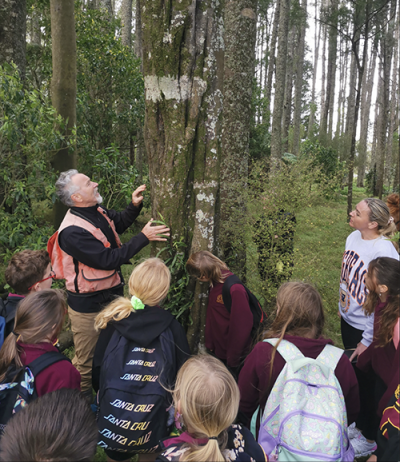As the year three and four students at Netherton School searched the dusty storage cupboard, little did they know the frightfully exciting discovery that lay in wait.
Cloaked in darkness, hidden beneath the old school supplies, they uncovered something entirely unexpected – a brilliantly-constructed bat hotel!

Despite the spooky associations of the abode’s prospective inhabitants, the kids weren’t scared – they were intrigued.
How did it get there? How did it work? Were there bats near the school? And how would they like this new hangout?
Deputy Principal Alicia Paterson swiftly enlisted the support of Enviroschools facilitator Jo Buchan to help the students learn more about these fascinating creatures and their habitat.
The Enviroschools programme empowers students to plan, design and create more sustainable schools. Supported and delivered in our region by Waikato Regional Council, it continues to grow, with 49 per cent of schools in the Waikato now enrolled.
Jo also got bat expert Ric Balfour from NZ Landcare Trust involved. The trust is a grassroots organisation that supports communities undertaking beneficial environmental management practices.
Ric recently found that there were pekapeka (bats) in a nearby tītoki tree at Gerard Hill Reserve.
He explained how lucky we are to have indigenous pekapeka-tou-roa (long-tailed bats) living right here in our region.
They’re a critically endangered species, threatened by loss of habitat, vulnerable to invasive predators (like cats, stoats, and rats), and in competition with humans for remaining habitat.
Not only are bats the only native land mammal in New Zealand, they’re the only flying mammal in the world!
And, despite their unearned reputation, these elusive creatures bring a range of biodiversity benefits, from insect control to pollination.
Long-tailed bats are smaller than the short-tailed variety. They weigh only 8-11 grams, about the same as a dollar coin. But they can fly at up to 60km/h, using echolocation to hunt small moths, midges, mosquitoes and beetles.
 There’re very maternal too. One student commented: “I can't believe the mother bat can fly with her pup tucked under her wing!".
There’re very maternal too. One student commented: “I can't believe the mother bat can fly with her pup tucked under her wing!".
Ric had been monitoring the local population and showed the rangatahi a graph plotting the frequency of bat sightings on his bush monitor.
After answering a colony of questions, he took the classes out to the tītoki to assess the natural habitat and learn how it could be made even better for bats.
The children set tracking tunnels and investigated holes in a nearby tītoki and kahikatea that they thought the bats would love to use as their roost.
They felt the cold wind blow through the west end of the bush and learnt that this area needed more plants to create a wind block. But, otherwise, it was a great location.
After taking care of a few creature comforts – considering pest trapping and possible tree planning – the students planned to hang their bat hotel in the titoki next term.
Netherton School have been doing a wonderful job, but bats still remain undervalued in conservation efforts.
You can help by protecting standing dead trees and old-age trees with hollows and cavities – the natural roosting spots of long-tailed bats.
You could also consider planting large trees for future bat generations or even building your own bat hotel.
Meanwhile, Waikato Regional Council will be doing our bit by supporting the Bat Alliance – which coordinates collaboration between mana whenua, councils, the Department of Conservation and others to help bats flourish – and Project Echo, a bat advocacy group that runs local bat monitoring and education events.
Project Echo is a great partnership between government agencies, ecologists, community groups and individuals who all have a passion to protect bats. They also carry out a fascinating survey each year to see how many bats there are in Kirikiriroa Hamilton, which you can find here.





To ask for help or report a problem, contact us
Tell us how we can improve the information on this page. (optional)